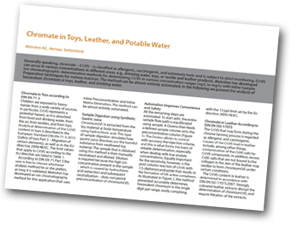Generally speaking, chromate – Cr(VI) – is classified as allergenic, carcinogenic, and extremely toxic and is subject to strict monitoring. Cr(VI) can occur in various concentrations in different areas, e.g., drinking water, toys, or textile and leather products. Metrohm has developed ion chromatographic determination methods for determining Cr(VI) in various concentration ranges (ng/L to mg/L) with Inline Sample Preparation techniques for various matrices. The method can be almost entirely automated. This article presents the analysis of hexavalent chromium in toys, leather, and drinking water.

Children are exposed to heavy metals from a wide variety of sources. In particular, Cr(VI) represents a potential hazard, as it is absorbed from food and drinking water, from the air, from textiles, and from toys. Analytical determination of the Cr(VI) content in toys is described in the European Standard DIN EN-71-3-2013 (Safety of toys Part 3 – Migration of certain elements), as well as in the EU directive 2009/48/EC. 
According to DIN EN 71 Part 3 the user is free to choose whichever analysis method he or she prefers, as long it is validated. Metrohm has developed an ion chromatography method for this application that uses Inline Preconcentration and Inline Matrix Elimination. The method can be almost entirely automated.
Sample Digestion using Synthetic Gastric Juice
Chromium(VI) is extracted from the toy material at body temperature using hydrochloric acid. This type of sample digestion simulates how gastric juice dissolves out the harmful substance from swallowed toy material. The sample that is obtained using this method is then manually neutralized and diluted. Dilution is required because the high ion concentration present in the sample – which is caused by hydrochloric acid extraction and subsequent neutralization – does not permit preconcentration of chromium (VI).
Automation Improves Convenience and Safety
All the remaining steps are automated. To start with, the entire sample flow path is equilibrated using sample. A Dosino then feeds a defined sample volume onto the preconcentration column. The Dosino allows to control with accuracy the injection volume, and this is what forms the basis of reliable determination, especially when dealing with low analyte concentrations. Equally important for the sensitivity, however, is the post-column reaction of Cr(VI) with 1,5-diphenylcarabazide that results in the formation of VIS active complexes. The method presented accurately determines hexavalent chromium in the single digit ppt range, easily complying with the 10 ppt limit set by the EU directive 2009/48/EC.




